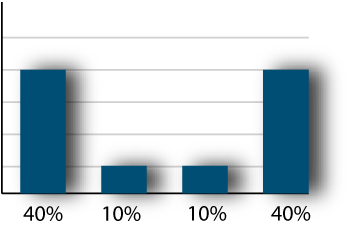Multi-Touch Attribution: What It Is & How To Use It
A buyer's journey spans through many devices and touchpoints before resulting in a conversion. In order to optimize campaigns and create more personalized consumer experiences, marketers need to understand which touchpoints and messages a consumer came in contact with that resulted in a positive action.
The goal is to understand where to allocate your marketing spend. When marketers can understand the role that certain touchpoints played in a conversion, they can more effectively devote funds to similar touchpoints in future media plans and divert funds from ineffective channels.
What is Multi-Touch Attribution?
Multi-touch attribution is a method of marketing measurement that accounts for all the touchpoints on the customer journey and designates a certain amount of credit to each channel so that marketers can see the value that each touchpoint has on driving a conversion.
For example, let’s say that a consumer is considering purchasing a new pair of shoes. After doing some research, they are targeted by ads from Nike. First, they see a display ad, which they ignore. Next, they see a native ad on their Instagram feed that catches their attention and drives them back to the Nike site. Finally, they get a promotional offer via email with a discount code that causes them to purchase.
Each of these ads represents a touchpoint in the buyer journey. Multi-touch attribution allows marketers to look at the native ad and the email campaign and attribute the sale to those efforts. They can then also note that the display ad was ineffective and shift away from that tactic.
There are several multi-touch attribution models marketers can rely on that look at user-level data, i.e., the effect that user-level events (clicks, impressions) have on the ultimate goal. Each of these models scale ad effectiveness differently.
The Difference Between Multi-Touch Attribution vs. First-Touch vs. Last Touch Models
One of the simplest ways to understand what multi-touch attribution is, is to understand what it isn't. Let’s take a look at how MTA compares and contrasts with other attributional models, including first and last touch attribution:
First-Touch Attribution vs. Multi-Touch Attribution
The first-touch attribution model gives full sales credit to the first marketing touchpoint interacted with before a conversion. Some marketers will use this to show how their top-of-the-funnel marketing materials generated initial awareness, eventually leading to a sale.
For instance, if you bought a pay-per-click ad on paid search, that touchpoint would get all of the credit, even if the customer interacted with your business across tens or hundreds of different touchpoints. This means that your product pages, television advertisements, events, and even the salespeople at your organization get no credit for a conversion whatsoever.
While first-touch attribution does help marketers understand which touchpoints are effective at the beginning of a customer’s journey, it pays no mind to the middle or end of their journey. For that reason, first-touch attribution is typically only used in niche situations.

Last-Touch Attribution vs. Multi-Touch Attribution
This model gives full sales credit to the last marketing touchpoint interacted with before conversion. Last-touch attribution is often used by marketers that want to focus purely on what drove conversions, rather than focusing on awareness or nurturing.
Imagine that a consumer clicked on a paid advertisement for your product, read the product page, and viewed several television advertisements over the course of a week. However, they didn’t decide to buy your product until they saw an impressive billboard on their way to the mall. Under this model, the billboard would get all the credit - but when you can see the entirety of the buyer’s journey, it’s clear that the billboard was only building upon your previous interactions.
Last-touch attribution is used more often than first-touch attribution, but it falls victim to many of the same pitfalls. What about your first touchpoint? What about all of the touchpoints in the middle? Unfortunately, under a last-touch attribution model, every other touchpoint is irrelevant to the sale.

Benefits of Multi-Touch Attribution
Multi-touch attribution models have become important for marketers, especially those looking to measure the impact of digital campaigns. This is because they provide a more granular, person-level view than traditional aggregate methods such as media mix modeling.
One of the top benefits of multi-touch attribution is that it provides visibility into the success of touchpoints across the entire customer’s journey. This is critical, as consumers are becoming increasingly adept at avoiding marketing messages. Marketers must utilize data-driven marketing to customize their messaging to meet consumers on the right channel at the right time. The granular data offered by multi-touch attribution enables this, helping marketers to identify audiences across channels and determine those users’ specific marketing desires.
In addition to helping marketers improve the consumer experience, multi-touch attribution also helps marketers to achieve higher marketing ROI for their marketing investments, illuminating where spend is most and least effective. This can also help to shorten sales cycles by engaging consumers with fewer but more impactful marketing messages.
It is important to note that not all attribution models are multi-touch. Multi-touch only refers to models that evaluate and weigh the impact of several touchpoints. For example, the first touch and last- touch models are forms of single-touch attribution. This is because they only factor in either the first or last touchpoint that was encountered before a conversion, rather than every touchpoint engaged with throughout the sales cycle.
Types of Multi-Touch Attribution Models
There are several popular multi-touch attribution models that look at each touchpoint engaged with before conversion. The key difference between these models is how much sales credit they ascribe to each touchpoint in the customer’s journey. Marketing teams can either adopt these models as is or use them to create their own custom models. Let’s take a closer look.
Linear Multi-Touch Attribution Model
Linear attribution gives each touchpoint across the buyer journey the same amount of credit toward driving a sale. While this type of attribution considers every touchpoint in the buyer’s journey, it values every touchpoint evenly.
For example, if a customer viewed a native ad and an email from Nike, each touchpoint would earn 50 percent of attribution credit. However, if you added several other touchpoints – such as a television advertisement and a sponsored tweet on an athlete’s twitter – each touchpoint would now be credited with 25 percent of the attribution credit.
In reality, consumers aren’t equally impacted by every kind of touchpoint. A consumer could see 99 Nike advertisements and not make a purchase until they see LeBron James promoting his new line of shoes on his Twitter. Under linear attribution, LeBron would only win about one percent of the credit even though it’s clear he made a considerable contribution to making that sale.
So, while linear attribution beats first or last touch attribution, it leaves a lot to be desired. While you’re not ignoring any touchpoints in your analysis, you’re still no closer to understanding which touchpoint had the most impact.

U-shaped Multi-Touch Attribution Model
The U-shaped model attributes 40 percent each to the first touchpoint and lead conversion touchpoint. The other 20 percent is divided between the additional touchpoints encountered in between. This gives your team a good understanding of which touchpoints start the customer journey, and which touchpoints led the customer to convert.
If you refer back to the previous example, this would help give LeBron the credit that he deserved for making that conversion. Now, he would be credited with 40 percent of the conversion, while the first television advertisement that a consumer saw would be credited with another 40 percent. All the other touchpoints – such as YouTube ads, display ads, and more, would split the last 20 percent of credit evenly.
This type of model is a bit more sophisticated than the linear attribution model because it understands that not every touchpoint is equal. It more accurately reflects how marketers intrinsically value touchpoints since it values both the beginning and the end. However, it’s not perfect by any means because it has a very simple approach to the middle of a customer’s journey.

Time Decay Multi-Touch Attribution Model
The time decay model gives more credit to the touchpoints a consumer interacts with closer to the conversion. This model primarily focuses on touchpoints at the bottom of the funnel, although it gives some credit to touchpoints in the top and middle of the funnel as well.
Let’s call back to the Nike example again and imagine that the customer only saw four touchpoints for the sake of simplicity. Under this model, the first television ad the customer saw would only get 5 percent of the credit (first touchpoint), while LeBron’s twitter would get half the credit (final touchpoint). If a customer saw a display advertisement before they visited LeBron’s twitter, that advertisement would get 25 percent of the credit, while a previous touchpoint would only 20 percent of the credit.
This model values touchpoints that directly lead to a conversion and gives little weight to awareness-based touchpoints. Depending on your marketing team’s philosophy, this model could be appropriate or a bit short-sighted. Conversions are essential to keeping your business alive, so they certainly deserve plenty of credit. However, would the customer have ever converted if they weren’t exposed to the first touchpoint? For that reason, not every marketing team will find time-decay modeling to be appropriate.

W-shaped Multi-Touch Attribution Model
The W-shaped model primarily credits the first touch, lead creation, and opportunity creation touchpoints, assigning each with about 30 percent of the credit. The remaining 10 percent is divided among additional engagements.
For instance, imagine that a consumer’s first touchpoint was a commercial for a new line of Nike shoes. When they were browsing the internet that day, they came across several ads that made them want to take a closer look at the shoes that Nike had on offer. So, they visited the Nike website, found the line of shoes, and signed up for their mailing list to get updates on new additions to the product line – this represented the “lead creation.” However, the customer left without making a purchase.
Later, they were checking their email when they got a conveniently timed promotional email from Nike that showed which shoes high-profile athletes preferred. In that email, they saw that Lionel Messi looked particularly sharp in a pair of Nikes – so, they followed a link to Nike’s online store and purchased the shoes. This email caused the opportunity creation and would get 30 percent of the credit.
Any touchpoints like display advertisements, sponsored Instagram advertisements, and more would have to share the final 10 percent of the credit. This model is a good choice when there’s a clearly identifiable “opportunity creation” stage taking place. However, it’s not always easy to neatly categorize pieces of the buyer’s journey, so this model isn’t without its flaws.

Full Path Multi-Touch Attribution Model
Full path is a highly technical and sophisticated model. It follows a similar sequence as the W-shaped model but incorporates an additional touchpoint — the lead creation touchpoint, which describes the moment that your team realized a customer became a qualified lead. Under this model, 22.5 percent of the credit is given to the first touch, lead creation, opportunity creation, and the final customer close touchpoint, with 10% going to any additional touchpoints.
This type of multitouch attribution is very common in B2B spaces, or for purchases that require a great deal of customer consideration – such as the automobile industry. So, let’s focus our example on a nice set of wheels instead of a nice pair of shoes.
Imagine a consumer that’s in the market for a luxury car. The first time they’re exposed to a Tesla advertisement, it’s a sleek, short-form tweet from the company’s Twitter that a car enthusiast retweeted. After looking at Tesla’s Twitter page, they quickly become interested in the company and follow them on Twitter. Both of these touchpoints represent the first touchpoint and lead creation, respectively.
About a week later, the customer sees an advertisement to design their own Tesla. Just for fun, they design a Tesla, but start to become overwhelmed with the features. Instead, they decide to schedule a virtual consultation and let a representative help them design the best car for them. When they schedule the consultation, they’ve hit the “opportunity creation” touchpoint. Finally, when they have a consultation with a salesperson, they convince them to custom order a Tesla Model S with a variety of bells and whistles. As soon as the customer signs their virtual contract, they’ve hit the final customer close touchpoint.
In this setting, the tweet, Twitter page, the landing page that led them to schedule a consultation, and the salesperson would get 22.5 percent of the credit each. Other touchpoints – such as the advertisement or Design-a-Tesla page, would split the remaining 10 percent. As you can see, full path attribution modeling provides a very granular view of the customer’s journey. In fact, it’s so granular that it might not be a great fit for businesses that focus on low-involvement purchases.

Custom Multi-Touch Attribution Model
A custom model is created by the organization and allows them to weigh the significance of each touchpoint based on their own rules. This is extremely helpful for marketers who want the best of several worlds. For instance, maybe they love the granularity of the full-path attribution model, but they don’t love how little credit it gives to certain touchpoints.
However, keep in mind a custom model can be complex to devise, and you need an advanced marketing attribution software in order to customize your attribution strategy in the first place. If a custom attribution model sounds like a good fit for your organization, be prepared to experiment with different kinds of models and study their benefits and drawbacks.
How to Implement Multi-Touch Attribution
Multi-touch attribution can be challenging to set up. It’s difficult enough to choose the best model for your business’s needs, but this difficulty is further compounded by the increasingly complex customer journey. Today’s customers hop across multiple devices, channels, and platforms before they decide to make a platform, and tracking them can be tricky with rising privacy concerns.
However, that doesn’t mean that you shouldn’t get started – the sooner you start, the faster you can begin optimizing your attribution strategy. Marketers looking to deploy multi-touch attribution models should consider the following steps for the most effective results:
Step 1: Determine the Models and KPIs
Marketers need to determine which attribution models to employ based on their organizational goals. When choosing the models, considerations such as length of sales cycle and types of campaigns should be factored in. From there, marketers must select their KPIs. These will be the metrics by which to measure success or failure. Marketers using MTA are typically trying to improve ROI and user experience, so these metrics must reflect what this means for the specific organization.
Step 2: Establish the Team
Next, marketing teams must align with key team members and stakeholders. This will of course mean coordinating with skilled marketing analysts, but also budget stakeholders and creative teams in order to optimize messaging based on insights.
Step 3: Deploy Marketing Analytics Software
When working with multiple complex attribution models, an advanced analytics software is necessary to normalize and correlate the data into digestible metrics from which insights can be derived. This platform should offer person-level, granular data, as well as other insights that might indicate the motivation behind a conversion, such as brand equity or effective creative.
Step 4: Apply Insights
Once marketers feel they have a complete understanding of how their campaign has performed based on the data provided by their attribution model, they can apply those insights in real-time to begin course correcting, allowing them to create a more customized experience.
Step 5: Continue to Optimize & Test
This should not be a one-time exercise. Rather, marketers should be continuously evaluating their MTA data to optimize and test campaigns. Regular optimizations and tests will enable marketers to determine the best strategies and marketing sequences to reach their consumers at the right time.
When to Use Multi-Touch Attribution
Multi-touch attribution models should be applied to campaigns that are based on digital spend, such as email or online paid advertising that run across multiple channels and devices, so long as marketers must be able to tie an individual to the marketing event. Insights from MTA can also be applied to automation platforms for tasks such as email deployment.
Finally, MTA data is a crucial part of all optimization and A/B testing efforts. This data will show the messages that resonate with your consumers on which channels and at which times, allowing marketers to optimize campaigns and messaging to meet those needs.
The Difference Between Multi-Touch & Multi-Channel Attribution
While multi-touch and multi-channel attribution are often used interchangeably, there are some notable differences between these two models. Multi-channel attribution weighs attribution credit by channel (social, paid, organic, etc.). It does not factor in specific touchpoints, messaging, or sequence. Multi-touch attribution is more granular, focusing on specific ads, including which channel they ran on, the message, and the sequence of interaction.
Challenges of Multi-Touch Attribution
While multi-touch attribution models provide more insights than other marketing measurements, they are not perfect. As marketers aim to perfect their attribution measurements, there are a few main challenges they face.
- Lack of Offline Metrics
MTA is largely used for campaigns that employ digital marketing platforms, as it measures consumer actions (clicks, etc). This makes it challenging for these models to incorporate offline data, such as exposure to a TV or print ad. However, these can be crucial components of the consumer journey.
- Data Wrangling
None of these models can provide full visibility into the customer journey. Therefore, marketers will have to employ multiple models, then correlate the data from each for the most accurate insights. The volume of data and complexity of the models then pose a challenge, with many marketing analysts spending more time aggregating this information in a digestible way than deriving meaningful insights from it. The need to use multiple attribution models exacerbates this challenge.
- Limited Visibility into External Factors
Unlike media mix modeling, which looks at aggregate data, MTA looks at user-level insights. Without incorporating aggregate information, marketers do not have visibility into external trends that might affect marketing efforts and conversions, such as seasonality.
Multi-touch attribution models are necessary but incomplete on their own. This is why marketers must employ unified marketing measurement. Unified measurement combines the person-level data offered by MTA with the aggregate data of media mix modeling for a comprehensive view of marketing engagements and trends.
Multi-Touch Attribution Enables Flexibility
As markets continuously evolve and consumer expectations adapt to a new normal, flexibility will be key for marketing teams. Multi-touch attribution enables flexibility by allowing marketers to have a more granular understanding of what is and isn’t working within their initiatives. With complete visibility of every touchpoint along the customer journey, teams can make informed, data-driven decisions for future marketing campaigns.


